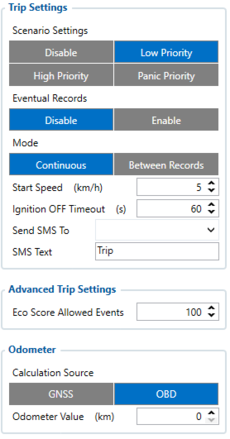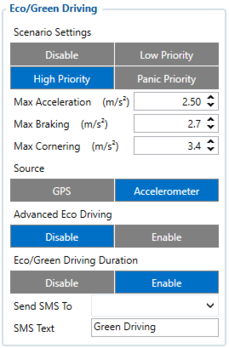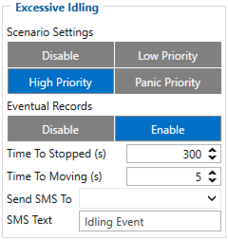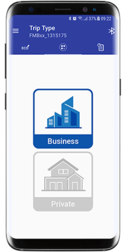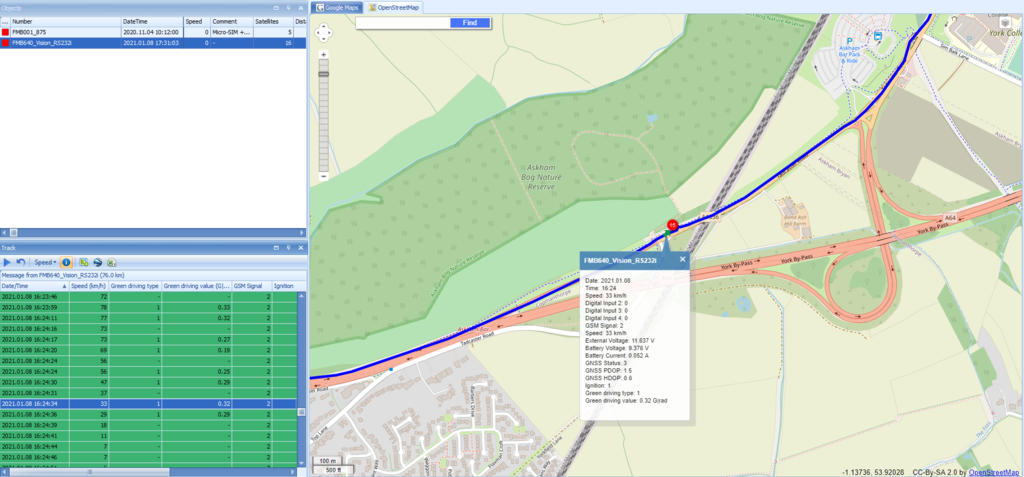GPS Electronic Logbook
Project description
It is a good practice for the companies all over the world a vehicle log to be kept for each automobile so that a fleet manager can keep tracking the operational cost of any particular car and/or the entire fleet. Although, manually handled paper reports leave a lot of space for failure. Starting of basic human errors, paperwork overload, lack of drivers accountability, communication and coordination issues, chaotic routing, excessive idling and up to no clear differentiation between business and personal vehicle use. These challenges will inevitably take an effect on the fleet operational cost, company cash flow, competitive advantage and reputation. All these obstacles can not be ignored and should be taken into account. And that is where Teltonika GPS electronic logbook solution comes into the play.
Teltonika GPS electronic logbook offers two operational modes: Private Mode and Business Mode. In the latter mode - location and the date of departure, driver's ID, mileage at the beginning and the end of the journey (distance travelled in total), green driving parameters, purpose of the trip will be tracked automatically. If Private Mode is chosen by the driver, the logbook will be turned off and no events will be registered.
We are glad that You decided to test our "GPS electronic logbook" solution.
Here You will find how to prepare and to test this solution.
What will You need for the solution?
- Teltonika FM device which is compatible with this use case. Recommended products: FMB001, FMC001, FMM001, FM3001, FMU126, FMB002, FMB010, FMB003 or FMB020.
- The SIM card in order to receive data to Your server.
- Teltonika Configurator to set up FM device correctly for the solution.
- FOTA WEB to remotely send the configuration to the device.
- BTAPP / Driver application for Private Mode or Business Mode selection.
Installation
Most of recommended products are "Plug and Play" devices. It means that devices are directly plugged into vehicles OBDII socket and after configuration is complete - devices are set. Although, if plugged OBDII device is too hard to reach and vehicle parts are interfering with GPS signal or vehicle parts need to be removed/opened to access OBDII socket and afterwards parts no longer fit or close - Teltonika offers OBDII extension cable. [1]
Keep in mind, that FMU126 device is not "Plug and Play" type and requires more advanced installation. [2] Also, particular FM device is specially built for Thailand region.
Apart from device configuration (more later) and installation into vehicle, GPS electronic logbook doesn't require additional hands on work.
Configuration
Prerequisites
Before configuring GPS electronic logbook solution it is mandatory to set up GPRS settings for a device. Quick first start guide can be found here.
Configuring GPS electronic logbook
After familiarizing with devices first start guide and device's GPRS settings are set - configuration for GPS electronic logbook can be done.
Parameter ID - Parameter name
Trip settings:
- 11800 - Scenario priority (0 - Disable, 1 - Low, 2 - High, 3 - Panic).
- 11801 - Eventual settings (0 - Disable, 1 - Enable), if disabled - trip settings will come with periodical data.
- 11802 - Mode (0 - Continuous, 1 Between Records). If Between Records option is selected distance will be counted until any record is made. Then odometer will be reset to zero and start counting until next record is made.
- 11803 - Start Speed (km/h).
- 11804 - Ignition OFF timeout (s).
- 7031 - ID of SMS recipient.
- 8031 - SMS Text.
- 700 - Eco Score Allowed Events.
- 11806 - Odometer Calculation Source (0 - GNSS, 1 - OBD).
- 11807 - current Odometer Value (km). Odometer data will be counted from provided value.
Eco/Green Driving settings:
- 11000 - Scenario priority (0 - Disable, 1 - Low, 2 - High, 3 - Panic).
- 11004 - Maximum Acceleration (m/s2).
- 11005 - Maximum Braking (m/s2)
- 11006 - Maximum Cornering (m/s2)
- 11007 - Source (0 - GPS, 1 - Accelerometer). Green driving scenario according to selected data source.
- 11019 - Advanced Eco Driving (0 - Disable, 1 - Enable). If enabled, Eco Driving Average (ID.: 11011) and / or Eco Driving Maximum (ID.: 11015) settings can be changed.
- 11008 - Eco/Green Driving Duration (0 - Disable, 1 - Enable).
- 7034 - ID of SMS recipient.
- 8034 - SMS Text.
Note: Maximum acceleration, braking and cornering values should be set according to vehicle type, power, weight and etc. Best values can be approached by practical testing.
Excessive Idling settings:
- 11200 - Scenario priority (0 - Disable, 1 - Low, 2 - High, 3 - Panic).
- 11203 - Eventual settings (0 - Disable, 1 - Enable), if disabled - excessive idling data will come with periodical data.
- 11205 - Time To Stopped (s). Represents how long vehicle should not move with engine ON.
- 11206 - To To Moving (s). Represents how long vehicle should be moving with engine ON, to exit idle state.
- 7033 - ID of SMS recipient.
- 8033 - SMS Text.
Quick start: From default configuration to GPS electronic logbook records in one SMS:
" setparam 11800:1;11801:0;11806:1;11000:2;11007:1;11200:2"
This SMS will set up Your device to send Trip, Eco/Green driving and Excessive idling data to Your previously provided server.
Note: Before SMS text, two space symbols should be inserted if no SMS username or password was set in SMS / Call settings.
BTAPP Mobile application
After making configuration for Your device, it is time to download BTAPP. Keep in mind, app and device connection is established via Blue-tooth. Devices by default come with Blue-tooth enabled and visible. After pairing to device - You can change the trip type of Your trips by performing a long press on the icon and confirming the change.
Parsing GPS electronic logbook records
Prerequisites
First of all, in order to parse packets with GPS electronic logbook records it is mandatory to open TCP or UDP port. Instructions can be found here.
After establishing TCP or UDP port, packets can be parsed automatically. In order to learn how it is done, please visit Java Parser First Start Guide.
Parsing example
| Unparsed received data in hexadecimal stream |
|---|
| 000000000000005E08010000017716AE03D8010F0F22D720982E9C007E00120A002FFD1609E
F01F00150011505C80045010101FD03FE230BB5000BB60006423A0018002F430F8A4400000 901301100161200EC13FBD90F038402C7000003BD1003066802000100005F75 |
| AVL Data Packet Part | HEX Code Part |
|---|---|
| Zero Bytes | 00 00 00 00 |
| Data Field Length | 00 00 00 5E |
| Codec ID | 08 (Codec 8) |
| Number of Data 1 (Number of Total Records) | 01 |
| Timestamp | 00 00 01 77 16 AE 03 D8 (Mon Jan 18 18:07:19 UTC 2021) |
| Priority | 01 |
| Longitude | 0F 0F 22 D7 |
| Latitude | 20 98 2E 9C |
| Altitude | 00 7E |
| Angle | 00 12 |
| Satellites | 0A |
| Speed | 00 2F |
| Event IO ID | FD (AVL ID: 253, Name: Green driving type) |
| N of Total ID | 16 |
| N1 of One Byte IO | 09 |
| 1’st IO ID | EF (AVL ID: 239, Name: Ignition) |
| 1’st IO Value | 01 |
| 2’nd IO ID | F0 (AVL ID: 240, Name: Movement) |
| 2’nd IO Value | 01 |
| 3’rd IO ID | 15 (AVL ID: 21, Name: GSM Signal) |
| 3’rd IO Value | 05 |
| 4'th IO ID | 50 (AVL ID: 80, Name: Data mode) |
| 4'th IO Value | 01 |
| 5'th IO ID | C8 (AVL ID: 200, Name: Sleep Mode) |
| 5'th IO Value | 00 |
| 6'th IO ID | 45 (AVL ID: 69, Name: GNSS Status) |
| 6'th IO Value | 01 |
| 7'th IO ID | 01 (AVL ID: 1, Name: Digital Input 1) |
| 7'th IO Value | 01 |
| 8'th IO ID | FD (AVL ID: 253, Name: Green driving type) |
| 8'th IO Value | 03 (01 - harsh acceleration, 02 - harsh braking, 03 - harsh cornering) |
| 9'th IO ID | FE (AVL ID: 254, Name: Green Driving Value) |
| 9'th IO Value | 23 ( Depending on green driving type: if harsh acceleration or braking - g*100 (value 123 ->1,23g). If Green driving source is "GPS" - harsh cornering value is rad/s*100. If source is "Accelerometer" - g*100. |
| N2 of Two Byte IO | 0B |
| 1’st IO ID | B5 (AVL ID: 181, Name: GNSS PDOP) |
| 1’st IO Value | 00 0B |
| 2’nd IO ID | B6 (AVL ID: 182, Name: GNSS HDOP) |
| 2’nd IO Value | 00 06 |
| 3’rd IO ID | 42 (AVL ID: 66, Name: External Voltage) |
| 3’rd IO Value | 3A 00 |
| 4'th IO ID | 18 (AVL ID: 24, Name: Speed) |
| 4'th IO Value | 00 2F |
| 5'th IO ID | 43 (AVL ID: 67,Name: Battery Voltage) |
| 5'th IO Value | 0F 8A |
| 6'th IO ID | 44 (AVL ID: 68, Name: Battery Current) |
| 6'th IO Value | 00 00 |
| 7'th IO ID | 09 (AVL ID: 9, Analog input 1 |
| 7'th IO Value | 01 30 |
| 8'th IO ID | 11 (AVL ID:17, Name: Axis X) |
| 8’th IO Value | 00 16 |
| 9'th IO ID | 12 (AVL ID:18, Name: Axis Y) |
| 9’th IO Value | 00 EC |
| 10'th IO ID | 13 (AVL ID:19, Name: Axis Z) |
| 10'th IO Value | FB D9 |
| 11'th IO ID | 0F (AVL ID: 15, Name: Eco score) |
| 11'th IO Value | 03 84 |
| N4 of Four Byte IO | 02 |
| 1'st IO ID | 02 C7(AVL ID: 199, Name: Trip Odometer) |
| 1’st IO Value | 00 00 03 BD |
| 2’nd IO ID | 10 03(AVL ID: 16, Name: Total Odometer) |
| 2’nd IO Value | 06 68 80 20 |
| Number of Data 2 (Number of Total Records) | 01 |
| CRC-16 | 00 00 5F 75 |
In platform
Packet information can be displayed visually. In the picture below, event location is displayed on the map. Dot on the map represents a record. By clicking on it, it is possible to see what kind of information is gathered in the particular entry.
In order to visually see received information:
- TAVL: Open TAVL → select client → select Street Map → select device → choose the date from which to which to show the records → push advanced → push show button and then you will see in left down corner all information.
- WIALON: Open WIALON → open messages → push unit ( select your device) → choose the date from which to which to show the records → select message (data messages) → push execute button and you will see all information.
